 W
WA pond is an area filled with water, either natural or artificial, that is smaller than a lake. It may arise naturally in floodplains as part of a river system, or be a somewhat isolated depression. It may contain shallow water with aquatic plants and animals.
 W
WA kettle is a depression/hole in an outwash plain formed by retreating glaciers or draining floodwaters. The kettles are formed as a result of blocks of dead ice left behind by retreating glaciers, which become surrounded by sediment deposited by meltwater streams as there is increased friction. The ice becomes buried in the sediment and when the ice melts, a depression is left called a kettle hole, creating a dimpled appearance on the outwash plain. Lakes often fill these kettles; these are called kettle hole lakes. Another source is the sudden drainage of an ice-dammed lake. When the block melts, the hole it leaves behind is a kettle. As the ice melts, ramparts can form around the edge of the kettle hole. The lakes that fill these holes are seldom more than 10 m (33 ft) deep and eventually become filled with sediment. In acid conditions, a kettle bog may form but in alkaline conditions, it will be kettle peatland.
 W
WBeaver dams or beaver impoundments are dams built by beavers to provide ponds as protection against predators such as coyotes, wolves, and bears, and to provide easy access to food during winter. These buildings modify the natural environment in such a way that the overall ecosystem builds upon the change, making beavers a keystone species. Beavers work at night and are prolific builders, carrying mud and stones with their fore-paws and timber between their teeth.
 W
WA beel is a billabong or a lake-like wetland with static water (as opposed to moving water in rivers and canals - typically called khaals in Bengali, in the Ganges - Brahmaputra flood plains of the Eastern Indian states of West Bengal, and Assam and in the country of Bangladesh. The term owes its origins to the word of the same pronunciation meaning "pond" and "lake" in the Bengali and Assamese languages.
 W
WBlackford Pond is a small, artificial pond in the Blackford area of Edinburgh, Scotland.
 W
WBomb Crater Pond is a pond in the Walthamstow Marshes in the London Borough of Waltham Forest.
 W
WA cooling pond is a man-made body of water primarily formed for the purpose of cooling heated water and/or to store and supply cooling water to a nearby power plant or industrial facility such as a petroleum refinery, pulp and paper mill, chemical plant, steel mill or smelter.
 W
WA detention basin or retarding basin is an excavated area installed on, or adjacent to, tributaries of rivers, streams, lakes or bays to protect against flooding and, in some cases, downstream erosion by storing water for a limited period of time. These basins are also called "dry ponds", "holding ponds" or "dry detention basins" if no permanent pool of water exists. Detention ponds that are designed to permanently retain some volume of water at all times are called retention basins. In its basic form, a detention basin is used to manage water quantity while having a limited effectiveness in protecting water quality, unless it includes a permanent pool feature.
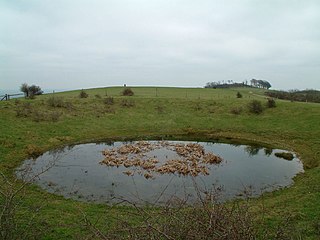 W
WA dew pond is an artificial pond usually sited on the top of a hill, intended for watering livestock. Dew ponds are used in areas where a natural supply of surface water may not be readily available. The name dew pond is first found in the Journal of the Royal Agricultural Society in 1865. Despite the name, their primary source of water is believed to be rainfall rather than dew or mist.
 W
WA duck pond is a pond for ducks and other waterfowl. Duck ponds provide habitats for water fowl and other birds, who use the water to bathe in and drink.
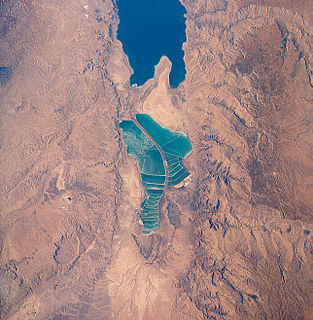 W
WEvaporation ponds are artificial ponds with very large surface areas that are designed to efficiently evaporate water by sunlight and exposure water to the ambient temperatures.
 W
WA garden pond is a water feature constructed in a garden or designed landscape, normally for aesthetic purposes, to provide wildlife habitat, or for swimming.
 W
WIn Islam, the Pond of Abundance refers to a pond or river that exists in Paradise. The traditional Muslim belief is that on the Day of Judgement, when people will be resurrected, they will rise in great thirst and be eager to quench it in an atmosphere of chaos. Then, Muhammad would be the one privileged by God to respond to the pleas of believers to quench their thirst by offering them a cool and refreshing drink from the pond.
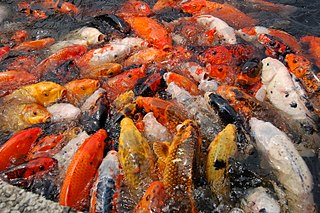 W
WKoi ponds are ponds used for holding koi, usually as part of a landscape. Koi ponds can be designed specifically to promote health and growth of the Nishikigoi or Japanese Ornamental Carp.
 W
WA log pond is a small natural lake or reservoir used for storage of wooden logs in readiness for milling at a sawmill. Although some mill ponds served this purpose for water powered sawmills, steam-powered sawmills used log ponds for transportation of logs near the mill; and did not require the elevation drop of watermill reservoirs.
 W
WMelt ponds are pools of open water that form on sea ice in the warmer months of spring and summer. The ponds are also found on glacial ice and ice shelves. Ponds of melted water can also develop under the ice.
 W
WA mill pond is a body of water used as a reservoir for a water-powered mill.
 W
WA raceway pond is a shallow artificial pond used in the cultivation of algae.
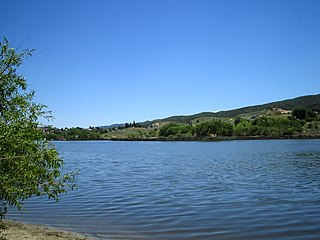 W
WA sag pond is a body of fresh water collected in the lowest parts of a depression formed between two sides of an active strike-slip, transtensional or normal fault zone.
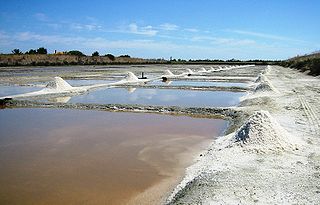 W
WA salt evaporation pond is a shallow artificial salt pan designed to extract salts from sea water or other brines. Natural salt pans are geological formations that are also created by water evaporating and leaving behind salts. Some salt evaporation ponds are only slightly modified from their natural version, such as the ponds on Great Inagua in the Bahamas, or the ponds in Jasiira, a few kilometres south of Mogadishu, where seawater is trapped and left to evaporate in the sun.
 W
WA sediment basin is a temporary pond built on a construction site to capture eroded or disturbed soil that is washed off during rain storms, and protect the water quality of a nearby stream, river, lake, or bay. The sediment-laden soil settles in the pond before the runoff is discharged. Sediment basins are typically used on construction sites of 5 acres (20,000 m2) or more, where there is sufficient room. They are often used in conjunction with erosion controls and other sediment control practices. On smaller construction sites, where a basin is not practical, sediment traps may be used.
 W
WA settling basin, settling pond or decant pond is an earthen or concrete structure using sedimentation to remove settleable matter and turbidity from wastewater. The basins are used to control water pollution in diverse industries such as agriculture, aquaculture, and mining. Turbidity is an optical property of water caused by scattering of light by material suspended in that water. Although turbidity often varies directly with weight or volumetric measurements of settleable matter, correlation is complicated by variations in size, shape, refractive index, and specific gravity of suspended matter. Settling ponds may be ineffective at reducing turbidity caused by small particles with specific gravity low enough to be suspended by Brownian motion.
 W
WA solar pond is a pool of saltwater which collects and stores solar thermal energy. The saltwater naturally forms a vertical salinity gradient also known as a "halocline", in which low-salinity water floats on top of high-salinity water. The layers of salt solutions increase in concentration with depth. Below a certain depth, the solution has a uniformly high salt concentration.
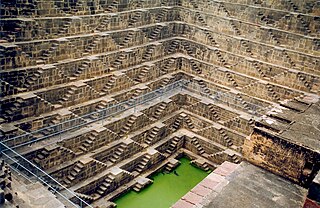 W
WStepwells are wells or ponds in which the water is reached by descending a set of steps to the water level. They may be multi-storied with a bullock turning a water wheel to raise the well water to the first or second floor. They are most common in western India and are also found in the other more arid regions of the Indian subcontinent, extending into Pakistan. The construction of stepwells is mainly utilitarian, though they may include embellishments of architectural significance, and be temple tanks.
 W
WWaste stabilization ponds are ponds designed and built for wastewater treatment to reduce the organic content and remove pathogens from wastewater. They are man-made depressions confined by earthen structures. Wastewater or "influent" enters on one side of the waste stabilization pond and exits on the other side as "effluent", after spending several days in the pond, during which treatment processes take place.